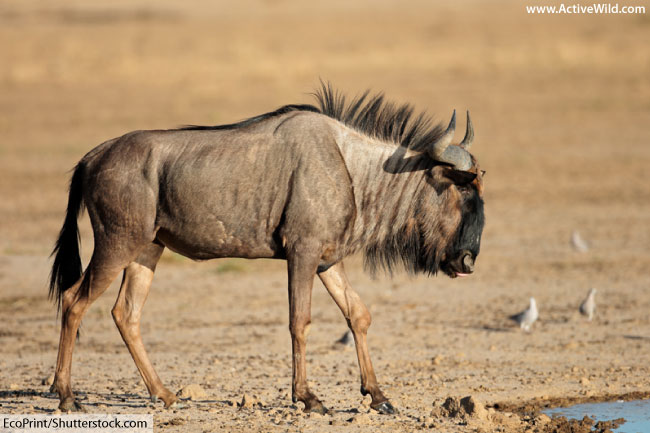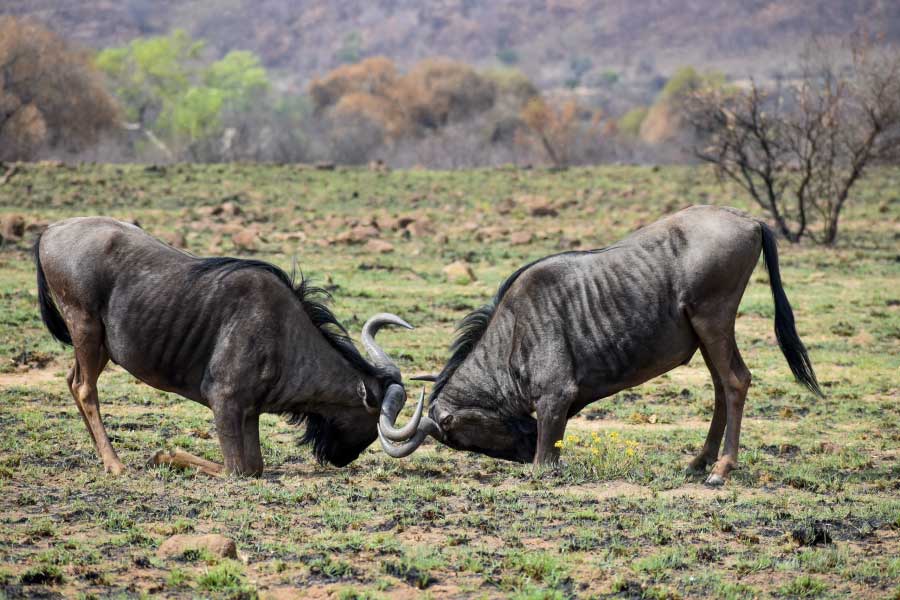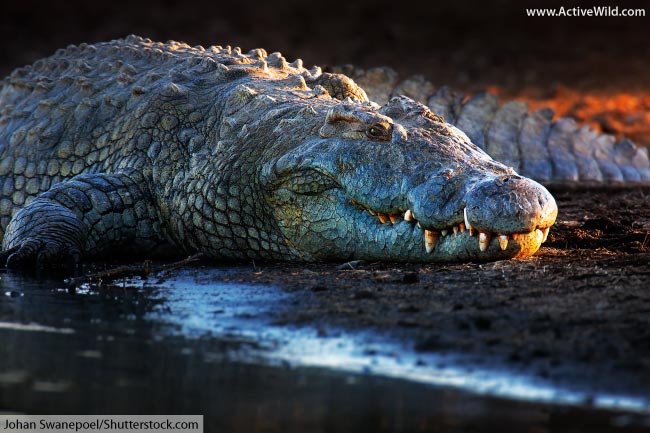The annual blue wildebeest migration in East Africa is the world’s largest land migration, and one of the most famous of all natural spectacles.
During their annual circular migration, huge herds of over a million blue wildebeest travel a distance of around 1,000 miles (1,600 km) in search of fresh grazing and water.
Challenges faced by the blue wildebeest during the journey include crossing crocodile-infested rivers and the continuous threat of predation by animals such as lions, hyenas and cheetahs.

Many thousands of the herbivores, weakened by starvation, thirst, fatigue or injury, either drown or succumb to the abundant predators.
The blue wildebeest migration is important not only for the region’s ecosystem, but also for its tourist industry. The migration passes through parts of Tanzania and Kenya, where safari companies and tour guides help tourists experience the awe-inspiring events associated with this age-old natural phenomenon.
Blue Wildebeest Migration Page Index
- What Is A Blue Wildebeest?
- Blue Wildebeest Life Cycle
- The World’s Largest Land Migration
- Migration Route
- River Crossings
- Other Animals That Migrate With The Blue Wildebeest
- Predators
- Human Influences
- References
What Is A Blue Wildebeest?
The blue wildebeest (Connochaetes taurinus) is a large antelope found in parts of southern and eastern Africa. A member of the family Bovidae, the herbivorous mammal lives in large herds and grazes on grass on the open plains of the region.

The name “wildebeest” was given to the animal in the 1700s by Dutch settlers in southern Africa. (The name comes from the Dutch for “wild beast”.)
Since then, the wildebeest has been separated into two species: the blue wildebeest, and the smaller, less-migratory, black wildebeest (Connochaetes gnou).
Wildebeest are also known as gnus – the name given to the species by local tribespeople prior to the arrival of Dutch settlers. ‘Gnu’ is reminiscent of the gentle moo sound that wildebeest make as they wander the grassy plains.
The plural term for many wildebeest is the same as the singular term, much as we refer to one sheep and many sheep.
Male blue wildebeest are bigger than females. An average adult male stands 59 in (150 cm) tall at the shoulder and weighs around 550 lb. (250 kg), whereas adult females have an average height of 53 in (135 cm) and weigh around 400 lb. (180 kg).
Both male and female wildebeest have horns that extend sideways and downwards before curling up at the tips.
Blue wildebeest are not really blue, but rather dark brown in color. However, when standing in the shadows, their bodies can look steely grey, and this is the origin of their name.
Wildebeest Life Cycle
The breeding season for wildebeest is in late May. The males form and defend temporary territories and attract females by calling to them and fighting off rival males.

Breeding is timed to occur when the grass is at its lushest and the wildebeest are in peak condition.
Calves are born about eight months later, around the end of January. All of the young are born within the space of three to four weeks. This provides safety in numbers, as the calves are a prime target for many predators, in particular the spotted hyena. The large numbers of calves being born at the same time decreases an individual’s chance of predation while at its most vulnerable.
Calves are born about eight months later, around the end of January. All of the young are born within the space of three to four weeks.
At this time the calves are a prime target for many predators, in particular the spotted hyena. The large numbers of calves being born at the same time decreases an individual’s chance of predation while at its most vulnerable.
Despite this, as many as 50% of blue wilderness calves die within the first few months of being born.
A newly-born wildebeest can stand up within minutes of being born. This enables it to join the safety of the herd and is critical for its survival.
The World's Largest Land Migration

Each year, blue wildebeest herds in the Serengeti (Tanzania) and Masai Mara (Kenya) wildlife areas undergo their famous migration. The migration is driven by the search for fresh grazing and water, and is influenced by weather patterns in the area.
Wildebeest in these two wildlife areas number about 1.5 million individuals and most of the animals undertake this journey every year.
Blue Wildebeest Migration Route
The grasslands of southern Serengeti provide an ideal habitat for blue wildebeest. It is here that the calves are born (anywhere up to 500,000 of them) in late-January, while the grasses are rich with minerals such as calcium, phosphorus and magnesium.
The wildebeest would likely stay in this region all year if they were able. Unfortunately, the grazing pressure of 1,5 million wildebeest is too much for the grasses and, by the end of May, the vegetation has become decimated.
This is also the end of the rainy season and so, running short of food and water, the wildebeest are forced to migrate.
The herds begin to walk westwards and northwards, into an area known as the “Western Corridor” of the Serengeti. The calves are now a few months old and able to keep up with the herd.

During June and July, the wildebeest begin to turn slowly northwards, grazing as they go. This is the dry season and water becomes progressively scarcer.
By the end of July, the herds have arrived in northern Serengeti and southern Kenya, with many gathering around the banks of the Mara River – the only permanent source of water in this vast area.
The wildebeest remain in the north, congregating near water, until late October, when the short rains begin.
These rains bring new life to the grassy plains in the south, and it is in this direction that the herds now begin to move.
The wildebeest arrive back in the southern Serengeti just in time to calve. Here they once again feed upon the newly-restored, nutrient-rich grasses of the region.
After a short stop to give birth, the dwindling grasses again force the herd to begin their long migration.
In total, the blue wildebeest migration takes around seven months, during which time the animals travel a distance of up to 1,000 miles (1,600 km). The females carry their unborn young for the entirety of the journey.
Blue Wildebeest Migration River Crossings

As if the journey were not arduous enough, the herds of migrating wildebeest have to cross two major rivers – first the Grumeti River, then the Mara River – on their way to the north.
This is a dangerous time for the wildebeest; lying in wait for them in the rivers are numerous crocodiles.

If the river is low then the crossing is simple and quick. If, however, the river is flowing strongly, the wildebeest must swim, giving the crocodiles more of a chance to pick off the young, weak and injured.
A crossing can see thousands of wildebeest launching themselves into the water and swimming with all their might. Many get trampled and crushed, some are killed by crocodiles, and a large number drown.
Scientists calculate that 6,250 wildebeest drown each year in the Mara River alone (Subalusky et al., 2017). This is equivalent to over 1,000 tons of biomass and comparable to dumping the carcasses of 10 blue whales into the river.
The nutrients from the dead wildebeest enrich the entire river system, feeding not only the crocodiles, but also vultures, fish, and numerous other scavengers and decomposers.
Amazingly, most of the calves and mothers manage to re-unite on the other side of the river. From here they continue on their journey northwards.
Unfortunately for the wildebeest, they will have to make the perilous river crossings once again on the southwards leg of their circular migration.
Animals That Migrate With The Blue Wildebeest

The blue wildebeest is not the only species to make this annual migration. The wildebeest are accompanied by 200,000 zebras and 260,000 gazelles (Thompson’s and Grant’s gazelles), although the gazelles do not make the entire journey.
These herbivores are all searching for green grass and water in order to survive. The different species eat different types and parts of the grasses, some preferring longer grass while others use the shorter tufts. In this way, competition for food is kept at a minimum.
The advantage of having so many animals migrating together is twofold: firstly, the extra eyes and ears help detect predators; secondly, the more herbivores there are, the less risk to each individual of being killed by a predator. This is a classic case of finding safety in numbers.
Blue Wildebeest Migration Predators

The huge herds of migrating antelope and zebras attract lions, leopards, spotted hyenas and cheetahs in addition to the crocodiles lying in wait in the rivers.
Lions and spotted hyenas are the dominant predators in the Serengeti system and are responsible for 85% of the predation on the herbivores.
Hyenas are three times as numerous as lions, and are known to hunt in packs in the Serengeti, rather than sticking to their usual role as scavengers.
Many wildebeest and zebras become weakened by hunger, thirst and fatigue. In addition, some sustain injuries while crossing the rivers. It is these individuals that usually fall victim to the predators.
It is estimated that at least 250,000 wildebeest and 20,000 zebras will die during the annual migration. These casualties are an important source of food for the region’s predators and scavengers.
Human Influences On Wildebeest Migration
Visitors come from all over the world to witness the blue wildebeest migration. Income from tourism contributes significantly to the national economies of Tanzania and Kenya and the tourist lodges and game safari operators employ many local people.

This is an age-old migration that is essential to the survival of the entire ecosystem. For it to continue in the future, the migration route needs to be protected from development. This is not easy as wildlife areas come under pressure from local people. Increasing populations need more land.
The biggest obstacles to the wildebeest movements are fences and roads. These can be devastating to migrating animals and need to be kept out of the Serengeti ecosystem. In addition, wild game is hunted and poached in many areas because the meat and hides are prized. This puts additional pressure on the herbivore populations.
Both the timing and the route of the wildebeest migration coincide with rainfall patterns – the rain needs to fall in order to refresh the grass and provide grazing and water for the animals. Climate change threatens to alter these patterns and could one day bring this magnificent natural spectacle to an end.
Further Reading & References
You can find out more about African animals on the following pages:
- African Animals List With Pictures & Facts. Discover Amazing Animals That Live In Africa
- List Of Crocodiles In Africa: Pictures, Facts & Information
- Nile Crocodile Information, Facts Pictures & Videos
- Animals That Migrate: A List Of Migratory Animals With Pictures & Facts
- African buffalo facts, pictures, video and in-depth information. Discover one of Africa’s most dangerous animals!
- African Reptiles List With Pictures & Facts: Discover The Amazing Reptiles Of Africa
- African Amphibians List With Pictures & Facts: Discover The Amazing Amphibians Of Africa
Kilungu, H., Leemans, R., Munishi, P. K. T., & Amelung, B. (2017). Climate change threatens major tourist attractions and tourism in Serengeti National Park, Tanzania. In Climate Change Management, 375–392. Springer. https://doi.org/10.1007/978-3-319-49520-0_23
Kittle, A. M., Bukombe, J. K., Sinclair, A. R. E., Mduma, S. A. R., & Fryxell, J. M. (2016). Landscape-level movement patterns by lions in western Serengeti: comparing the influence of inter-specific competitors, habitat attributes and prey availability. Movement Ecology, 4, Article 17. https://doi.org/10.1186/s40462-016-0082-9
Subalusky, A. L., Dutton, C. L., Rosi, E. J., & Post, D. M. (2017). Wildebeest mass drownings alter river ecosystem. Proceedings of the National Academy of Sciences, 114 (29), 7647–7652. http://doi.org/10.1073/pnas.1614778114
Ultimate Africa Safaris. (Undated). The wildebeest migration made simple. Ultimate African Safaris. https://www.ultimateafrica.com/wildebeest-migration/#:~:text=From%20the%20vast%20Serengeti%20plains,search%20of%20rain%20ripened%20grass.

